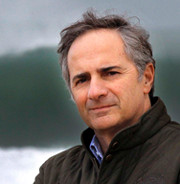Director General Ms. Valvanera Ulargui, Spanish Climate Change Oice, Spain
BIO: Since 2015 she is the Director General of the Spanish Climate Change Office. Her responsibilities are to put forward the national policy, according to the international and UE regulations about the climate change, in related matters with the emission’s commerce and flexibility mechanisms, so as the adaptation for the mitigation of the climate change. Before that, she worked at the Ministry of Economy and Competitiveness in the ICEX España Importación e Inversiones as external advisor for Infrastructure, Environment and TICs. From 2001 to 2013 she was external advisor as coordinator of international negotiations on climate change to the Ministry of Agriculture, Food and Environment: General Directorate of the Spanish Climate Change Office.
KEYNOTE: Climate change policies in Spain
ABSTRACT: Valvanera Ulargui, Director General of the Spanish Climate Change Office will give an overview of the new Spanish polices to tackle climate change in particular in the context of the process to prepare a national climate change and energy transition law. The Spanish Government is in the process of developing a law which aims to become the main regulatory tool in Spain to ensure that the country play its part in the international efforts to tackle climate change, aligning its actions with the Paris Agreement goals. This law will also set the framework which will allow Spain to be prepared to adapt to the impacts of climate change that it is already suffering, while making sure that the most vulnerable sectors and work forces in Spain are not left behind.
Mr. Hernan Kraviez, Head of Architecture, Design and Technology, Norman Foster Foundation, Spain
BIO: Hernan studied architecture at the School of Architecture, Design and Urbanism of the University of Buenos Aires, Argentina graduating with honours in 1996. In 1998 he took Professional Development courses at Harvard University’s Graduate School of Design and in 2003 received an MSc in Construction Economics and Management from the Bartlett School of Architecture, UCL, London. He joined Foster & Partners in 2004 where he worked for 14 years. As a Partner in the practice he was involved in a diverse range of projects and buildings types, from small scale interventions to large infrastructure projects. Since 2018 he is the Head of Architecture, Design and Technology of the Norman Foster Foundation in Madrid, leading a young team of architects in the design of innovative and experimental projects and prototypes that actively engage in interdisciplinary thinking in the built environment.
KEYNOTE: Environmental design cities: A holistic approach in an area of climate change policies
ABSTRACT: Cities are the future. Today, over 50% of the population lives in cities and by 2050 in excess of 70% will be urbanised. They consume over two-thirds of the world’s energy and account for more than 70% of global CO2 emissions. With over 75% of cities situated on coastlines, they are at high risk from the devastating impacts of climate change. They can also be the solution.
The Norman Foster Foundation focuses on promoting interdisciplinary thinking to help new generations of architects, designers, urbanists, engineers and civic leaders to anticipate and address the problems of the future. True collaboration between seemingly disconnected fields of design and thought is at the heart of a holistic approach to design that we believe is the key to the future of cities.
The Foundation seeks to promote two main streams of activities, one with a focus on research and education, and another with the goal of implementing practical and experimental projects around the world. This keynote address will share some of the knowledge that we are gaining through the development of innovative projects in association with other like-minded institutions, universities, and research centres.
Prof. Dr. Mr. QIN Tianbao, Professor of Law, Wuhan University, China
BIO: Prof. QIN Tianbao is the Luojia Professor of Law, and serves as the Director of the Research Institute of Environmental Law (RIEL) and the Associate Dean for the School of Law, Professor of China Institute of Boundary and Ocean Studies, Wuhan University, China; he is the Secretary-General of Chinese Society of Environment and Resources Law (CSERL); and a Lead Author and Review Expert of the Intergovernmental Platform on Biodiversity and Ecosystem Services (IPBES). He is a Legislative Expert for China’s Ministry of Environmental Protection and Ministry of Agriculture, and Hubei Provincial Parliament, and headed or participated in drafting of several major environmental bills. He is an Advisor for Chinese negotiations on biodiversity, ocean and climate change issues, and an Environmental Law Expert for several projects of International Financial Institutions in China.
KEYNOTE: Environmental taxation and big cities in China: A global vision
ABSTRACT: In China, environmental taxation, also known as eco taxation or green taxation is not clearly defined yet. However, it is well accepted by the government that the environmental taxation internalizes the social cost of ecological destruction and environmental pollution into the production cost, affects the producers’ and the consumers’ behaviors and the distribution of environmental resources through the market mechanism. Therefore, for the purpose of promoting eco-civilization and green development in China, among others, environmental taxation is strengthened and more frequently employed, especially in promotion the development of low-carbon cities.
Chinese government has set out its ambitious intensity reduction target; namely, by 2030 carbon emissions per unit of GDP would reduce by 60%-65% compared to 2005 which has been put it into national economic and social development plan as a binding goal. Since the cities gather major population and economy, the emissions in cities accounted for about 80% of the total (local emissions and indirect emissions caused by consumptions). Therefore, how to achieve “low carbon” cities has become the main content of actions when China addresses climate change with essence to reduce carbon emissions while developing the economy.
Chinese government has released many strategies, regulations and policies on low-carbon cities’ development. Correspondingly, China has established a basis system of environmental taxation with environmental protection tax and resources tax as the core body, with vehicle and vessel tax and other taxes, and tax reduction and exemption policy as supplementary body.
Specifically, from January 1st 2018 on, China imposes its Environmental Protection Tax (replacing “Pollution Discharge Fee, PDF”) and the new regime made distinction between light and heavy polluters, meaning that firms have more incentives to cut down on their emissions. And before that, China has started comprehensive its national resources tax reform since beginning of 2016. The main feature of the reform is to fully implement the ad valorem taxation method which is extended to most mineral products, such as crude oil, coal, natural gas, rare earth, molybdenum, and tungsten, though clay and sandstone will still be taxed by volume. Meanwhile, the Vehicles and Vessels Tax of 2012 reduced taxes on energy-saving and clean energy-powered vehicles, while imposing higher taxes on cars with big engines; what’s more, the State Council stated that buyers of new energy vehicles – fully electric, hybrid and fuel cell cars –would not have to pay the levy from September to the end of 2017. On the other hand, an environmental friendly and resources conserving firms could enjoy many tax reduction and exemption policies. For example, firms can enjoy tax benefits by comprehensively utilizing resources and purchasing equipments for environmental protection or energy saving and water saving.
Such a green tax system has been applied widely and comprehensively in industry, transportation, building, lifestyle and other key fields of low-carbon cities development, which eventually facilitate the adjustment of the economic structure and promote the transformation of the development mode of China. However, there are still different voices in this process. For instance, the fact that the environmental protection tax rates are decided at the provincial level could result in the migration of polluting agents to the more tax friendly regions of the country. Ad valorem taxation method has caused special burden on industries. And without gas tax, a person with a small car that frequently drives will discharge more air pollutant than a person with a large car that is driven infrequently. All these factors, if unidentified and unsolved properly, might undermine role of environmental taxation in promoting low-carbon cities in China.
In such circumstance, China shall revise and refine its environmental taxation system through learning by doing on one hand and successful experiences from other countries on the other hand. Perhaps, law and practice of China could contribute a lot to the globe in near future.
Director General Ms. Pilar Jurado, Department of Customs and Special Taxes at the State Agency for Tax Administration, Spain
BIO: State tax inspector since 1992. She has worked in various positions in the area of customs and special taxes, both in central and territorial services. She has participated in multiple international meetings in the field of European Union, Latin America and theWorld Customs Organization. She currently holds the position of Director of the Department of Customs and special taxes at the State Agency for Tax Administration, a department composed of 3,600 employees. She manages functions of facilitation and control of foreign trade operations and management of special taxes, as well as the pursuit of contraband and economic crimes.
KEYNOTE: An analysis of Sapnish green taxes, present and future
ABSTRACT: The effects of the polluting behaviour of our society, both by individuals and by companies, are currently an important topic in daily media (internet, social networks or blogs). Pieces of news related to the increase of forest fires, the decrease of water supplies, the rise of average global temperature, all this information could be encompassed under the label of “climate change” that is considered to be mainly produced by the impact of human actions on the environment.
The general political aim is achieving more environmentally friendly behaviors. However depending on the specific objectives pursued, fiscal authorities need to analyze the different available instruments and which ones of them are the most suitable for each objective. Their range goes from coercive measures to taxes and other instruments of joint responsibility such as subsidies, deductions or tax incentives.
It should not be forgotten that in order to protect the environment, alongside other measures, there are two basic requirements: general awareness of citizens and public and private efforts to achieve it. The protection of natural resources (such as water), the management of different types of waste, the avoidance of natural resources over-exploitation, all of them need financial resources and this is where public policies should be in balance with private action.
If, as a result of such analysis, taxation is considered a suitable instrument to achieve the goals of environmental policy, then it should be defined in a coherent manner, with long-term planning and taking into account all the effects that any fiscal measure may produce. There must be a clear identification of the taxable events, the actions and the products affected and how the tax administration can manage and apply these taxes.
Another important issue that must be addressed is the territorial jurisdiction. Speaking of Spain, for example, should the environmental taxation be established by the central government, the regions or the local governments? Double taxation must be avoided.
Furthermore, belonging to the European Union, another aspect to be considered is related to the internal market. Does a specific tax measure affect the free circulation of goods, persons and capital or the freedom of establishment?
Spain has already some taxes with environmental components, is there space and need for new ones?
Mr. Vicente Hurtado, Head of the Energy Taxation and other Indirect Taxes Unit, European Commission, Belgium
BIO: Vicente Hurtado Roa is the Head of the Unit in the European Commission responsible for Energy Taxation and other indirect taxes. His first steps in the Directorate General for Taxation started in 2006 when he was responsible for drafting the review of the Savings Directive before becoming the assistant to two previous Director Generals responsible for taxation. His experience in the European Commission also covers seven years in the Secretary General , working first on the European Semester and then in the relations with the European Council. Previously to join the European Commission, Vicente had been a tax consultant in Garrigues for ten years with an expertise in international taxation.
KEYNOTE: Taxation of transport from a EU perspective
ABSTRACT: Energy and vehicle (registration and circulation) taxes are two instruments that aim at both generating revenues for public budgets and at influencing technology and behaviour. They are typically embedded in a policy mix consisting of taxation, regulation, fiscal incentives and information campaigns targeting objectives such as reducing GHG emissions and promoting energy efficiency.
While energy taxation is harmonised at EU level, vehicle taxation is not. Council Directive 2003/96/EC sets in particular the minimum levels of taxation for products used as motor fuel and for electricity. Above the minima, Member States are free to set their national rates. The objective is to ensure that the internal market operates smoothly and to avoid double taxation or major distortions of trade and competition between energy sources and energy consumers and suppliers which could result from considerable differences in national tax rates. The directive also defines what exemptions and reductions are allowed and under which conditions. Some exemptions are mandatory, such as those on products supplied for use as fuel in air navigation or for navigation within EU waters. Optional exemptions or reductions also apply, for instance in favour of commercial gas oil, natural gas and LPG used as propellant or biofuels.
After Member States could not agree on a Commission’s proposal of 2011 to turn this directive into an instrument that would be better adapted to contribute towards achieving the EU climate change, energy and environmental goals, the Commission has recently engaged in a new evaluation of the directive to be finalised by the end of 2018. Recent commitments under the Paris Climate Agreement and under the 2030 Climate and Energy EU framework that for example set a cut of CO² emissions in the non-ETS sector by 30% (compared to 2005) and a binding target of at least 27% of EU energy consumption from renewables, justify a fresh look at the role of energy taxation. Besides this, developments in the energy market and technology maturity levels (e.g. with alternative fuels or with more sophisticated models of tax differentiation) evidence the limits of the current legislative framework.
Issues such as a different minimum rate for diesel and petrol or the introduction of a reduced rate for electricity used as propellant should be addressed. In the future, the potential for fuel taxes and distance- based taxes to raise revenues and to mitigate other externalities than carbon emissions such as pollution from other gases and congestion should be explored.
Prof. Dr. Mr. Iñigo Losada, Coastal and Ocean Engineering Professor, University of Cantabria, Spain
BIO: Iñigo Losada is a Coastal and Ocean Engineering Professor affiliated with the School of Civil Engineering of the University of Cantabria in Spain. Currently he is also Director of Research of the Environmental Hydraulics Institute “IH Cantabria” where he served as founding Director from 2007-2011. Prof. Losada holds a PhD from the University of Cantabria and a PhD from the University of Delaware where he held a Research Assistant position in the Center for Applied Coastal Research. His research interests have been mostly devoted to coastal dynamics, wave and structure interaction modelling, met-ocean climate and over the last decade climate change and marine renewable energy. Losada has co-authored over 150 publications and is one of the most cited authors in his field. From 2010-2014 he served as Coordinating Leading Author of the IPCC 5th Assessment Report on Climate Change and is currently contributing to the new report on Oceans. He is co-founder of the spin-off IDERMAR, S.L. (Research and Development for Marine Renewable Energy) and co-author of 7 patents of different technologies for both wave and wind energy, especially for deep water and has coordinated many projects for national and international corporations, administrations and development banks. He is a member of the American Society of Civil Engineering (ASCE) Coastal Engineering Research Council and Editor-in-Chief of Coastal Engineering (ELSEVIER). He has received several national and international awards including the 2017 John G. Moffat- Frank E. Nichol Harbor and Coastal Engineering Award of (ASCE).
KEYNOTE: Is Ocean energy ramping up in our future sustainable energy mix?
ABSTRACT: During the talk the different stages of technical and commercial development of the various ocean energy technologies (tidal, wave, ocean thermal conversion, salinity gradient) and offshore wind will be discussed. It will be shown that while offshore wind is becoming an essential part of the energy mix in many countries, ocean energy technologies are still facing a series of bottlenecks hindering their development including: technology development, financing of projects, legal and financial barriers, the lack of specific feed in tariffs or taxation policies and concerns regarding environmental impacts or social acceptance.
Offshore wind is an abundant and clean energy solution for many coastal areas where high concentrations of population and energy demand is located. Recent numbers show that an estimated 3.3 GW of new offshore has been installed in 2017, bringing the cumulative total installed offshore wind power to almost 17 GW. While the onshore wind market is still larger in terms of total megawatt installed capacity added annually, offshore wind is ramping up and growing more quickly. During the talk technological developments, related policies, incentives, and regulatory environments contributing to this rapid implementation will be discussed.
In Europe ocean energy has been identified as a key technological area within the Strategic Energy Technology Plan of the European Union. However, the installation of ocean energy devices is taking place at a slower pace than expected. While the installed capacity in offshore wind power is in the order of tens of GW, Europe only accounts for a dozen of MW of ocean energy installed capacity at the end of 2016.
Within ocean energy, tidal and wave energy technologies poised to become the most relevant contributors to the European energy mix in the short term. However, reliability and survivability are still some of the issues that need to be addressed by wave energy developers to ensure the long-term uptake and viability of this technology. Several demonstrator projects have shown that the tidal technology is viable. In order to move forward and deploy the first fully commercial projects, the tidal sector requires the development of innovative financial instruments able to attract private investments. However, ocean thermal energy conversion and salinity gradient technology are still at early stage of development, requiring research and development to progress further in terms of technology.
If ocean energy technologies are to become essential players in the potential decarbonisation pathways of our energy systems, new instruments need to be created to overcome specific barriers hindering future commercial deployment analogous to that expected for offshore wind.
Mr. Nils Axel Braathen. Principal Administrator in the Environment Performance and Indicators Division in OECD’s Environment Directorate, OECD, France
BIO: Nils Axel Braathen is a Principal Administrator in the Environment Performance and Indicators Division in OECD’s Environment Directorate. He has been with OECD since 1996, working i.a. on a database on instruments used for environmental policy, on environmental taxation, on economic valuation of environmental externalities regarding air pollution and chemicals, and has also taken part in some of OECD’s Environmental Performance Reviews. Prior to joining OECD, Braathen was a Deputy Director General in the Department for Long-term Planning and Policy Analysis in the Ministry of Finance, Norway. He holds a Master’s Degree in Economics from the University of Oslo, Norway.
KEYNOTE: Road transport, environmental protection and fiscal instruments
ABSTRACT: This presentation will discuss the drivers and magnitudes of externalities caused by road transport, such as the contribution to climate change, air pollution, noise and congestion. It will also give an overview of different fiscal instruments that affect road transport, focusing in particular on the current use of taxes on petrol and diesel, as well as on environmentally differentiated motor vehicle taxes. The fiscal challenges caused by a decarbonisation of the road transport sector will also be presented.
Prof. Dr. Mr. Xavier Labandeira, Professor of Applied Economics at the University of Vigo, Spain
BIO: Professor in the Department of Applied Economics at the University of Vigo, he belong to Rede, a research group that deals with the economic aspects of innovation, energy and the environment. He teaches public and environmental economics and he coordinates the Master’s degree in Management of Sustainable Development until 2014. He is also a director of Economics for Energy, a private research center that specializes in the analysis of energy issues and aims to create and transmit rigorous, neutral and useful knowledge to the different agents of Spanish society. Between 2014 and 2017 he was the director of the Florence School of Regulation-Climate at the European University Institute in Florence. Moreover, he was a lead author of the UN Intergovernmental Panel on Climate Change (IPCC) for the elaboration of its Fifth Assessment Report (released in April 2014). His research lies in the boundaries between public, energy and environmental economics: Prof. Labandeira also regularly participates in conferences and workshops, in many cases as the organizing host. He has led many research projects, both public and privately funded, and enjoyed several research stays at different universities abroad.
KEYNOTE: Crisis and reform of road transport taxation in the 21st century
ABSTRACT: Road transport has been traditionally subject to a number of fuel and vehicle taxes with revenue, infrastructure cost-coverage, or externality (environment and congestion) correction purposes. Yet, over the last few years, several factors have been undermining the operation and effectiveness of such taxes: i) pervasive local pollution and congestion problems that are only indirectly related to type of vehicle and fuel consumption, ii) trend towards a more energy efficient fleet, reducing the revenue capabilities of the system, and iii) increasing changes in mobility options (car sharing, etc.) In this paper we provide evidence of those factors and suggest a new approach towards transport taxation that is based on both the characteristics of the vehicle and its actual (time and location) use. Taxing the real use of a vehicle is now technologically feasible and can tackle the externalities associated to road transport in a more effective way (including local pollution, climate mitigation and congestion) while maintaining revenue-raising capabilities and providing sizeable tax revenues to different levels of government. Given the difficulties associated with an immediate tax transition to the new system, the paper also considers several alternatives to move from the current tax situation.
Prof. Ms. Janet Milne, Professor of Law and Director, Environmental Tax Policy Institute. Vermont Law School, USA
BIO: Janet E. Milne is Professor of Law and Director of the Environmental Tax Policy Institute at Vermont Law School, USA, where she has taught environmental taxation since 1994. She has written extensively about environmental taxation, including carbon taxes. Recent publications include J. Milne, ed., Environmental Taxation and the Law (Edward Elgar 2017) and J. Milne and M.S. Andersen, Handbook of Research on Environmental Taxation (Edward Elgar 2012). Before joining the law faculty, she was tax legislative assistant to US Senator Lloyd Bentsen, Chairman of the US Senate Committee on Finance, an attorney at Covington & Burling in Washington, D.C., and worked in the land conservation field. She is a graduate of Georgetown University Law Center and Williams College and clerked for Frank M. Coffin, Chief Judge of the US Court of Appeals for the First Circuit.
KEYNOTE: Innovation: From Pigou to the Digital World
ABSTRACT: Technological innovation has changed economies over the past three centuries from the Industrial Revolution to the new digital revolution. Each phase of change has generated benefits to society but also new threats to the environment. Since the mid-twentieth century environmental protection policies have been trying to keep pace, innovating to address the ever-emerging challenges as economies move forward. This paper looks back at how environmental taxation has responded to the consequences of technological innovation by engaging in its own innovation. The paper then turns forward to look at the emerging digital economy, which is the product of extraordinarily fast-moving and significant technological advances. It explores the role of environmental taxation in addressing the environmental challenges of the 21st century digital world. How might those environmental challenges intersect with environmental taxation? Does the nature of the digital economy affect the design of environmental taxes? Do the theories underlying environmental taxation need to evolve or do traditional theories stand stalwart?
Although much remains to be known about the future shape of the digital economy and its environmental consequences, the time seems right to consider about how governmental pricing policies might avoid or minimize the adverse consequences of a new economic revolution from its start—rather than waiting until patterns of behavior have been formed. This paper does not attempt to provide full answers to such a complex and multifaceted topic, nor could it. Selecting examples from the transportation and urban settings, it instead strives to highlight the question whether environmental taxation needs to innovate alongside the technological changes that increasingly drive economies and society around the world.
Last Modified 24/09/2018











